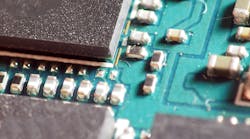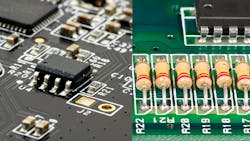What you’ll learn:
- The importance of SMT in PCB manufacturing.
- How SMT can be beneficial for PCB manufacturers.
Have you opened an electronic device and found some small component networks? You see pieces of different elements placed on your mobile, laptop, and microwave circuit boards, etc. Instead of using common equipment, the printed-circuit-board (PCB) manufacturer installs advanced components on the board surface using surface-mount technology (SMT).
What is SMT?
SMT connects electronic components—surface-mount devices (SMDs)—to the top and bottom surface of a PCB. Surface technology replaces pressing-fit or wave-solder, through-hole technology (see figure). Thanks to SMT PCB technology, designers are able to create smaller assemblies. SMT is a direct method that involves just placing and positioning the PCB component on the board.
SMT has a number of advantages including:
- Lower manufacturing costs: SMT allows for smaller PCB design production, shrinking production costs. SMT will respect the fact that placing the correct elements is essential.
- Improved efficiency: Another explanation why many PCB producers prefer SMT is better work efficiency. Using SMT, the circuit assemblies can be quickly turned in one prime, unlike press-fit technology that often takes time.
- SMT is easier to work with: With SMT, the configuration is clearer—the mounted SMT board doesn't require a lot of technical knowledge. Essentially, the SMT panel’s layout is simpler than that of other methods.
- Fewer defects: SMT technology also is beneficial in terms of managing errors. SMT facilities can easily cope with the necessary changes and modify the same. Thus, designers can create boards with little concern regarding errors during the process.
- Superior electromagnetic-compatibility (EMC) efficiency: With SMT, it’s possible to achieve a lightweight bundle along with lower lead activation. In this case, the electromagnetic structures possess greater efficiency.
- Automated assembly: Most SMT parts can be easily installed on circuit boards using automatic pick-and-place equipment. The high-volume section, such as passive components, is loaded from the roll, while the other area is loaded from the tube feeder or tray. This is significantly different than the pin through-hole (PTH) component that often must be collected manually.
- Better electrical performance: Due to their size, more SMT parts can fit on a board than PTH parts. Thus, you also end up with a shorter signal path. This leads to better PCB signal integrity and less generated heat as opposed to through-hole parts.
Difference Between Through-Hole and SMT
Some key differences exist between board creation technology that uses through-holes versus SMT. For example, SMT removes restrictions in spacing due to through-hole connections. Through-hole components typically have higher production costs relative to SMT.
On the flip side, SMT requires different and usually more sophisticated design and production skills. The lower production cost is offset by the high capital investment into machines that can handle SMDs. In addition, SMT components may have a higher number of pins than lead-based, through-hole components.
SMT components are more compact; hence, the higher component density of an SMT design as well as a lighter-weight board. Furthermore, because the board is more compact, it helps reduce electrical noise as well as susceptibility to electromagnetic interference (EMI). On top of that, eliminating holes for device connections can in turn reduce the number of holes needed for a PCB, thereby speeding production.

